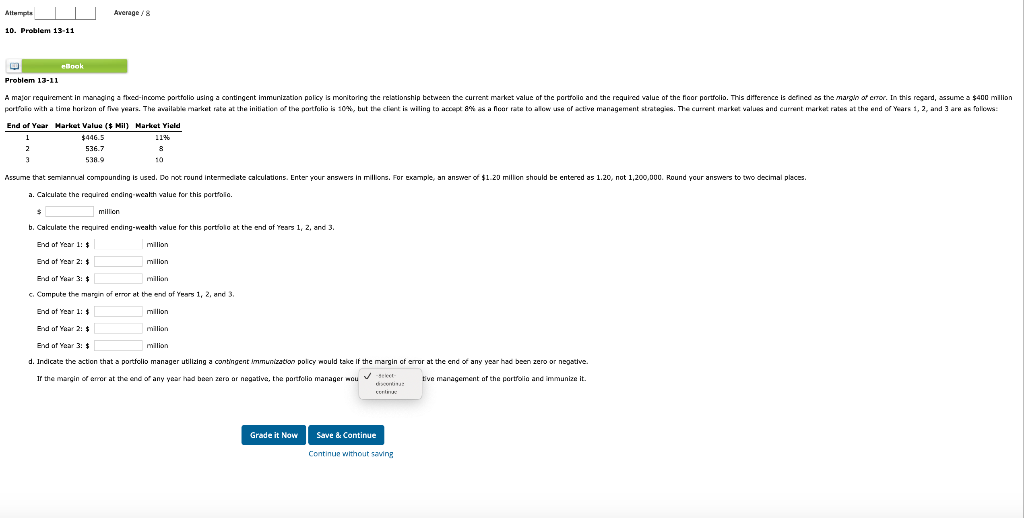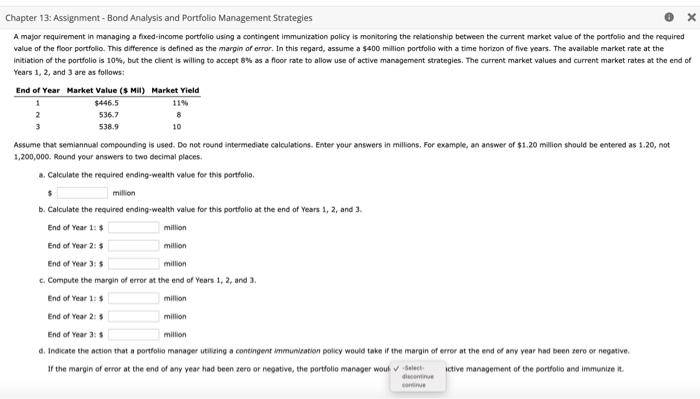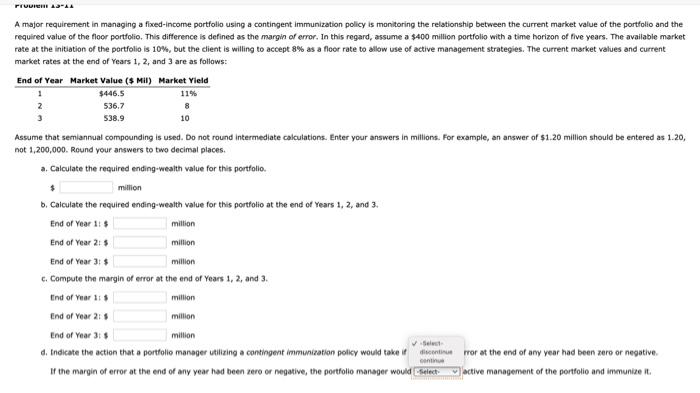
Attrmpte Average is enook Problem 13-11 \begin{tabular}{ccc} End of Year & Market Value \{\$ Mil\} & Market Yield \\ \hline 1 & $446.5 & 11% \\ 2 & 536.7 & 8 \\ 3 & 538.9 & 10 \end{tabular} a. Cakulate the required cnding-wealth walue for this portiolio. b. Cakulate the required ending-wealth value for this pertiolo at the end of rears 1,2 , and 3 . Grade it Now Save \& Continue Continue without sewing A major requirement in managing a fixed-income portfolio using a contingent immunization policy is monitoring the relationship between the current market value of the portfolio and the required value of the floor portfolio. This difference is defined as the margin of error. In this regard, assume a 5400 million portfolio with a time horizon of five years. The avaliable market rate at the initiation of the portfolio is 10\%, but the clent is willing to accept s\% as a floor rate to allow use of active mansgement strategies. The current market values and current market rates at the end of Years 1,2 , and 3 are as follows: Assume that semiannual compounding is ised. Do not round intermediate calculations. Enter vour answers in millions. For example, an answer of $1.20 milion should be entered as 1.20 , not 1.200,000. Round your answers to two decimal places. a. Calculate the required ending-wealth value for this portfolio. 5 million b. Calculate the required ending.wealth value for this portfolio at the end of Years 1, 2, and 3 . End of Year 1: $ milion End of Year 2: 5 million End of Year 3:5 milion c. Compute the margin of error at the end of Years 1,2 , and 3. End of Year 1: 5 million End of Year 2: s million End of vear 3:3 milion d. Indicate the action that a portfolio manager utilising a coneingent immumisation policy would take if the margin of error at the end of amy year had been zero or negative. If the margin of error at the end of any year had been zero or negative, the portfolio manser wou cive manbgement of the portfolio and immunize i. A major requirement in managing a fixed-income portfolio using a contingent immunization policy is monitoring the relationship between the current market value of the portfolio and the required value of the floor portfolio. This difference is defined as the margin of errer. In this regard, assume a $400 million portfolio with a time horizon of five years. The availabie market rate at the initiation of the portfolio is 10%, but the client is willing to accept 8% as a floor rate to allow use of active management strategies. The current market values and current market rates at the end of Years 1,2 , and 3 are as follows: Assume that semiannual compounding is used. Do not round intermediate calculations. Enter your answers in milions. For example, an answer of $1.20 million should be entered as 1.20, not 1,200,000. Round your answers to two decimal places. a. Calculate the required ending-wealth value for this portfolio. $ milion b. Caiculate the required ending-wealth value for this portfolio at the end of Years 1, 2, and 3. End of Year its miltion End of Year 2:s milion End of Year 3:$ million c. Compute the margin of error at the end of Years 1, 2, and 3. End of Year it 1 milion End of Year 2:1 End of Year 3:$ milion d. Indicate the action that a portfolio maneger valixing a contingent immunization policy would take if ror at the end of amy year had been zere or negative. If the margin of error at the end of any year had been zero of negative, the portfolio manager would active management of the portfolio and immunize it. Attrmpte Average is enook Problem 13-11 \begin{tabular}{ccc} End of Year & Market Value \{\$ Mil\} & Market Yield \\ \hline 1 & $446.5 & 11% \\ 2 & 536.7 & 8 \\ 3 & 538.9 & 10 \end{tabular} a. Cakulate the required cnding-wealth walue for this portiolio. b. Cakulate the required ending-wealth value for this pertiolo at the end of rears 1,2 , and 3 . Grade it Now Save \& Continue Continue without sewing A major requirement in managing a fixed-income portfolio using a contingent immunization policy is monitoring the relationship between the current market value of the portfolio and the required value of the floor portfolio. This difference is defined as the margin of error. In this regard, assume a 5400 million portfolio with a time horizon of five years. The avaliable market rate at the initiation of the portfolio is 10\%, but the clent is willing to accept s\% as a floor rate to allow use of active mansgement strategies. The current market values and current market rates at the end of Years 1,2 , and 3 are as follows: Assume that semiannual compounding is ised. Do not round intermediate calculations. Enter vour answers in millions. For example, an answer of $1.20 milion should be entered as 1.20 , not 1.200,000. Round your answers to two decimal places. a. Calculate the required ending-wealth value for this portfolio. 5 million b. Calculate the required ending.wealth value for this portfolio at the end of Years 1, 2, and 3 . End of Year 1: $ milion End of Year 2: 5 million End of Year 3:5 milion c. Compute the margin of error at the end of Years 1,2 , and 3. End of Year 1: 5 million End of Year 2: s million End of vear 3:3 milion d. Indicate the action that a portfolio manager utilising a coneingent immumisation policy would take if the margin of error at the end of amy year had been zero or negative. If the margin of error at the end of any year had been zero or negative, the portfolio manser wou cive manbgement of the portfolio and immunize i. A major requirement in managing a fixed-income portfolio using a contingent immunization policy is monitoring the relationship between the current market value of the portfolio and the required value of the floor portfolio. This difference is defined as the margin of errer. In this regard, assume a $400 million portfolio with a time horizon of five years. The availabie market rate at the initiation of the portfolio is 10%, but the client is willing to accept 8% as a floor rate to allow use of active management strategies. The current market values and current market rates at the end of Years 1,2 , and 3 are as follows: Assume that semiannual compounding is used. Do not round intermediate calculations. Enter your answers in milions. For example, an answer of $1.20 million should be entered as 1.20, not 1,200,000. Round your answers to two decimal places. a. Calculate the required ending-wealth value for this portfolio. $ milion b. Caiculate the required ending-wealth value for this portfolio at the end of Years 1, 2, and 3. End of Year its miltion End of Year 2:s milion End of Year 3:$ million c. Compute the margin of error at the end of Years 1, 2, and 3. End of Year it 1 milion End of Year 2:1 End of Year 3:$ milion d. Indicate the action that a portfolio maneger valixing a contingent immunization policy would take if ror at the end of amy year had been zere or negative. If the margin of error at the end of any year had been zero of negative, the portfolio manager would active management of the portfolio and immunize it









